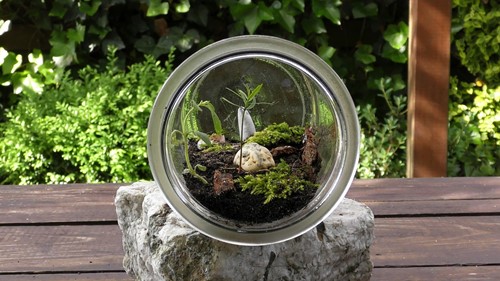
Image by AndyFaeth from Pixabay
If you're searching for ways to introduce a little extra green into your home and at the same time learn a satisfying hobby consider building a terrarium.
Putting together a terrarium is a learning experience for grown-ups and can draw in kids as well. Not only do you see your handiwork grow and thrive, but you’ll observe a real-life example of a working ecosystem. A terrarium, if it’s a closed one, recycles its oxygen, carbon dioxide and water.
What Is a Terrarium?
In simplest terms, it’s a glass container for growing plants. There’s a variation called a vivarium, a similar construction with small animals, but plants are a great starting point.
Terrariums (either “terrariums” or “terraria” is an acceptable plural) can be either open or closed. Open terrariums are better for plants that can’t tolerate moisture buildup.
How To Build a Terrarium
First, find a glass container. For a closed terrarium, any glass container with a removable lid will work. You can order one or find one around the house. It could be a rectangular glass box with a top or a rounded jar with a stopper. A Mason jar, either upright or on its side. A covered fishbowl. A cookie or candy jar. You can also use plastic if it’s clear and resists fogging.
Lay down a base. Use rocks, plain or colored gravel, seaglass or other decoratives. This is your drainage layer. It should be about an inch deep, but that can vary depending on the size and shape of your container. The finished product will need enough “headroom” for your little garden. The base layer doesn’t have to be flat; you may shape it to create peaks and valleys.
Some sources recommend a ½ inch layer of charcoal next as a water filtrate.
Create a barrier for your soil with sphagnum or sheet moss. Soak it briefly, squeeze out the water and mold it into place.
Add about two inches of soil. Common potting soil is good for most plants. If your gravel layer is flat your can shape this to make miniature hills and valleys.
Now you’re ready to plant. Use slow growing vegetation and dwarfs. Peperomia, ferns (maidenhead, button ferns), pilea and dwarf palms are good choices, as well as miniature coleus, violets, begonias. There are suitable lichens and mosses.
As for maintenance, there’s not much. After an initial watering, you have only to keep it moist. For a closed system, which recycles water, a light mist every few weeks is adequate. Once a week, briefly remove the cover to rebalance the air. Trim plants to keep them small. Terrariums do best in indirect sunlight. The glass can magnify direct rays.
About the Author

Carol McCullough Relocation Certified
As a Fairfield resident with a family commuting daily on Metro North, and our children graduating from Fairfield public schools, I look forward to sharing many of the great attractions in a wonderful community and county! Over the past 18 years with Berkshire Hathaway Home Services New England Properties, I have helped hundreds of buyers and sellers compete their home search and close on the sale of their property. As a Certified Relocation Specialist, my production results rank in the top 4% nationally while delivering exceptional customer service to my clients and their welcomed referrals. Real Estate is one of the most exciting investments you can make. It should be a fun and rewarding experience. Confident with your home marketing decisions and comfortable with the home marketing process is my commitment to you! I am excited to share several new marketing strategies successfully implemented in Southern Fairfield County! Regardless if you are looking to buy, or about to list your current home, you will soon BE AT HOME when working with Carol! *Connecticut Magazine 2022 Award Winner- 12th consecutive year scoring highest in overall customer satisfaction.
